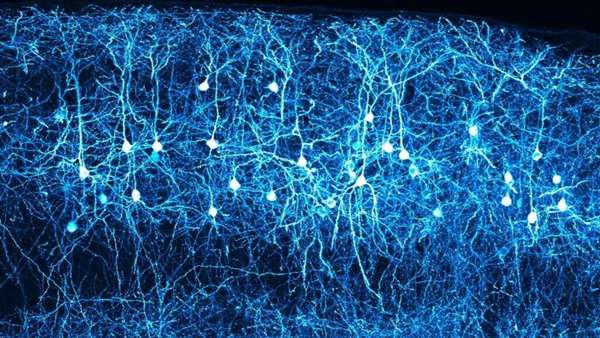The layered structure of nerve cells in the neocortex
The neocortex is a layered structure of the brain in which neurons are arranged parallel to each other. This organization is critical for healthy brain function.
The neocortex is a layered structure of the brain in which neurons are arranged parallel to each other. This organization is critical for healthy brain function. A team of researchers from Charité - Universitätsmedizin Berlin have uncovered two key processes that direct this organization. Reporting inScience Advances, the researchers identify one crucial factor which ensures the timely movement of neurons into their destined layer and, subsequently, their final parallel orientation within this space.
The neocortex is the outer region of the brain. It is responsible for cognitive functions such as language, decision-making, and voluntary movement. A highly organized structure, its component neurons are stratified horizontally into six layers in which neurons and their branched processes (dendrites) assume a parallel orientation to each other. In order to form this layered structure, neurons must first migrate from the ventricular zone—where they are generated by neural stem cells—to their final destination. "The structure of the neocortex determines its function. A good way to illustrate this is to think of the neocortex as a computer chip, where each component has its exact place. It takes a finely tuned sequence of cellular processes to ensure that all neurons reach their final destination and that they orient correctly within this space. Any disruption of these processes will result in cognitive impairments and neurological disorders," explains corresponding co-senior author Dr. Marta Rosário, who has been working with her team from Charité's Institute of Cell Biology and Neurobiology to determine the potential factors and mechanisms involved.
"We found that this layered structure only forms if newly generated neurons are able to start migration to their intended destinations at the right time. We were also able to show for the first time that, upon arrival, these cells undergo a process of reorientation to enable them to extend their main dendritic protrusion—the apical dendrite—in the direction of the cerebral membranes, and thus align in a parallel fashion to each other," says Dr. Rosário. She adds: "Only by completing these two key processes can neurons subsequently form the correct connections with other neurons, necessary for brain function."
Using a mouse model, the researchers were able to identify the regulatory protein Zeb2 as responsible for controlling both processes. In order to commence migration at the right moment, neurons must first detach from their original location, where they are firmly anchored within the surrounding 'extracellular matrix'. Zeb2 acts to restrict the production of the surface protein neuropilin-1, which is responsible for maintaining adhesion. To ensure that neurons can reorient themselves upon arrival in the cerebral cortex, Zeb2 employs another surface protein, cadherin-6, to control adhesion, ensuring that cell-cell and cell-matrix contacts occur in a balanced manner. Zeb2 therefore controls two crucial signaling pathways which are responsible for interactions between cells and their environment.
Mutations affecting Zeb2 play an important role in a rare genetic disorder known as Mowat-Wilson syndrome, which is associated with developmental and functional abnormalities affecting both the brain and the nerves supplying certain organs. Summing up the team's research findings, co-senior author Prof. Dr. Victor Tarabykin, Director of the Institute of Cell Biology and Neurobiology, says: "Thanks to our new insights regarding the two steps involved in neocortical development, we are now better able to understand the nature of the cellular defects which might underlie these types of functional brain abnormalities—or indeed other neuropsychiatric disorders such as autism and schizophrenia, which are also associated with similar developmental abnormalities." Dr. Rosário and her researchers are currently conducting further research to determine the role played by interactions between nerve cells and the surrounding extracellular matrix in neurological disorders.
https://medicalxpress.com/news/2021-07-cerebral-neocortex.html




ارسال به دوستان